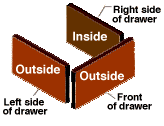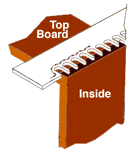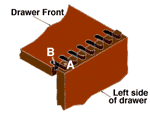 |
|
|
Dovetail Joints
The dovetail joint is possibly the best joint that you can use to join two pieces of wood together at a right angle. Not only is it a very strong joint, but it also adds to the appeal of the woodworking project. Even better; everyone "knows" that a dovetail joint is hard to do, and so people will be even more impressed with your handiwork!
While creating a traditional dovetail joint is not too difficult, it does take quite a long time; using a router speeds up this process considerably. The purists among you should stop reading now as you will not like this method at all...sorry!

The simplest way to create dovetail joints is to use a router and a dovetail template jig. The latter is available from any good home improvement store and can cost as little as $70. It's well worth the investment if you plan on doing many dovetail joints in the future.
Arrange the three pieces of the drawer or box as shown in the first diagram and mark the inside and outside of each piece. In addition, mark the ends of each piece as it is imperative that when cutting the dovetails the correct two ends are cut at one go.

Clamp the front of the drawer and one side into the dovetail machine as follows: the left side of the drawer should be clamped under the front clamp (pointing upwards towards the template) with the inside of the drawer pointing out; the front of the drawer - again with the inside pointing out -should be clamped under the top clamp so that it butts up against the left drawer (see the second diagram). These two pieces should be staggered slightly, rather than being aligned exactly. The precise measurement will depend upon the particular dovetail machine that you are using, and this distance will be supplied with its manual. However, it should be roughly in the region of 7/16 inch.
Once everything is tightly clamped in place, use the router to cut around the template, following the direction of the arrows in diagram two.

Once this is complete, the end result should look like diagram three. Dovetail A should be matched with slot B and so on.
It is well worth practicing with scrap wood before trying the above procedure on any project as it will take a while to get the exact measurements (such as the depth of the router cut) perfect.
If the joint is too loose, slightly increase the depth of the router cut. If the joint is too tight (remember that you still have to squeeze some glue into the joint), slightly decrease the depth of the cut.